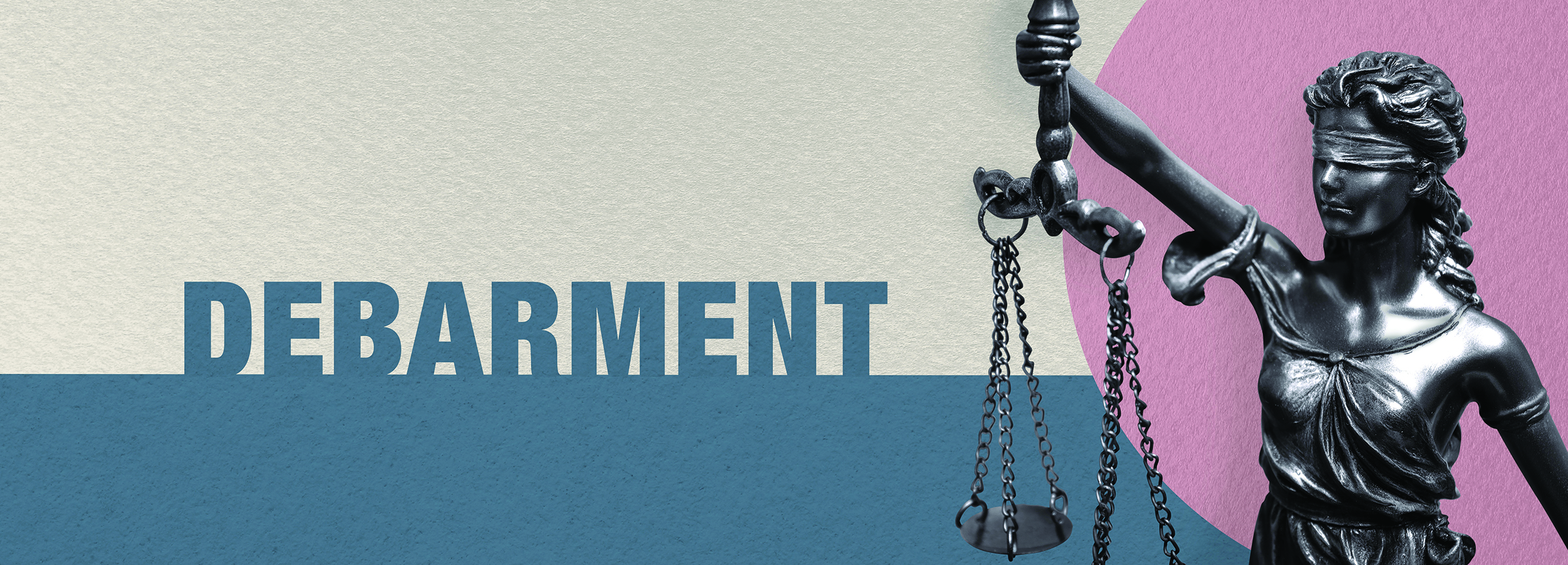
(Credit: MQIllustrations-adobe.stock.com)
Practice Notes
Punitive Versus Protective Debarment Regimes
The Protection of Government Interests through the Management of Procurement Risk
By Lieutenant Colonel Bruce L. Mayeaux
Many governments use an administrative process, commonly known as “debarment” to mark problematic contractors as ineligible for future public contracts.1 While many acquisition professionals view the United States’ administrative—or discretionary—debarment system as a punitive process, it is, in fact, a protective one.2 However, the current U.S. administration has recently issued a robust whole-of-government strategy on countering corruption, which has increased the Government’s focus on anti-corruption enforcement.3 If U.S. agency-level decision-makers, including those within the Army and the Department of Defense, decide to refine the administrative debarment process to be consistent with this strategy, they may ask—why should it remain protective?
The reason U.S. debarments should remain protective is that, in general, debarment regimes designed to punish contractors for prior bad acts are less effective than protective regimes at managing procurement risk. Present and future risk management is a major government interest, and the different regimes affect public procurement risk very differently in the long run.
A comparison of protective and punitive regimes reveals how they impact risk differently. First, punitive regimes can increase risk by discouraging contractor cooperation with Government investigations into alleged problematic conduct through severe and nondiscretionary sanctions. Second, they can increase risk by discouraging new firm participation in the marketplace, and, as a result, limiting competition. In contrast, protective regimes can decrease that risk. First, they encourage contractor cooperation by giving contractors an opportunity to prove they are presently “responsible,” meaning they have a satisfactory performance record, have shown integrity in their business dealings, and maintain appropriate business ethics.4 Second, they increase new-firm competition in the marketplace by using alternative methods to debarment.
This article briefly examines how governments use punitive and protective debarment regimes to manage risk, and why U.S. agency-level decision-makers should continue to tend towards a protective administrative debarment process to manage their public procurement risk.5
Types of Procurement Risk and How Debarment Regimes Manage Them
Protecting government interests through risk management is a consistent theme across public procurement systems throughout the world.6 Generally, this public procurement risk is broken down into three categories.7 First, performance risk, or the risk that a contractor will fail to perform on its contract with a government.8 Second, reputational risk, or the risk that the reputation of a government will suffer if it “contracts [or works] with a disreputable vendor.”9 Finally, fiduciary risk, or the risk that taxpayer dollars will be wasted or inappropriately spent.10 There is no clear separation between these categories of risk and a single matter could concern two—or more—at one time.11 However, while qualifying contractors, governments routinely seek to manage both reputational and performance risk, which tend to serve as central themes in their debarment regimes.12
Generally, governments—through their debarment regimes—tend to manage their interests by mitigating these risks in one of two ways. First, under a punitive debarment regime, governments use debarment more like a means to punish, or sanction, contractors for past deeds that have already increased performance or reputational risk to that government.13 An example of a punitive debarment regime is the one utilized by the World Bank. In that regime, if the contractor presents sufficient evidence to the decision-making body—the Integrity Vice Presidency—that they committed sanctionable conduct, then the burden to show the conduct was not sanctionable moves to the contractor.14 If the contractor is unsuccessful in proving its burden, then it is subject to mandatory sanctions.15
In other words, if the contractor cannot show that either it did not do the alleged conduct or its conduct was not sanctionable, there is no discretion—the contractor must be sanctioned.16 Evidence in mitigation only plays a role in how onerous the sanctions will be, and a present responsibility analysis is not involved.17 The focus of the Integrity Vice Presidency throughout this punitive process is the sanctionable conduct itself, not what the contractor has done to manage the sanctionable conduct.
In contrast, under a protective debarment regime, governments use debarment as a means to protect its current and future interests by refusing to do business with vendors that have unacceptable levels of performance or reputational risk.18 An example of a protective debarment regime is the one the U.S. Government uses now. What makes the U.S. Government’s regime protective, and distinguishes it from punitive regimes such as that of the World Bank, is a focus on present responsibility and the discretion given to decision-makers.19 Here, although the U.S. decision-maker—the suspension and debarment official (SDO)—may have evidence of sanctionable conduct, generally, they must consider any mitigation and remedial measures the contractor presents, along with the seriousness of the conduct, to determine whether the contractor is presently responsible.20 The SDO has great discretion as to not only the severity of sanctions but also whether to sanction at all.21 Both punitive and protective debarment approaches seem to entice contractors into compliance with law, regulation, and policy intended to mitigate the aforementioned risk.22 However, the punitive approach is less effective, as it can lead to increased performance and reputational risk.

(Credit: Wladimir1804-adobe.stock.com)
The Punitive Approach
Punitive debarment regimes are less effective than protective regimes at managing interests and mitigating risk because they can discourage contractor cooperation with investigations and, indirectly, severely limit competition. Punitive debarment regimes discourage cooperation with official investigations via harsh and often nondiscretionary sanctions that governments levy due to prior bad acts.23 Moreover, mitigating measures—such as cooperating with investigators—do not affect the likelihood of sanctions, only their severity.24 This is the case even if the contractor has made changes to address the cause of those acts.25 This lack of cooperation seems to also make it harder for governments to detect conduct that has increased its performance risk.26
Additionally, because contractor cooperation with investigations benefits the overall integrity of a procurement system, the lack of it affects a government’s reputational risk.27 This is because regimes that discourage cooperation could lead to less transparency and a more suspicious public. Indeed, the punitive debarment regimes’ discouragement of cooperation with contractors over official investigations can increase the likelihood of performance and reputational risk as opposed to mitigating it.
Second, punitive regimes seem to severely limit competition by discouraging new vendors from doing business with a government.28 Ostensibly, these new firms would fear the overly onerous punishment they could receive under a punitive debarment regime “if a subsidiary company, individual, or small group of individuals” did anything to increase that government’s performance or reputational risk.29 These regimes operate like a “zero-sum game” and inevitably lead to a smaller pool of contractors, which could lead to lower-quality products and services available to a government.30 Again, this likely increases, not decreases, both performance and reputational risk. Consequently, because the punitive approach realistically can increase both performance and reputational risk, it is less effective at managing it. In contrast, the protective approach is more effective at mitigating risk and, therefore, managing it.

(Credit: Elnur-adobe.stock.com)
The Protective Approach
Protective debarment regimes are more effective than punitive regimes at managing risk because they encourage contractor cooperation with official investigations and increase competition. As an initial matter, protective regimes deliberately consider their interest management by discretionally using debarment to mitigate their current and prospective—and not just retrospective—procurement risk.31 Stated in other terms, protective regimes tend to focus on a contractor’s present qualification—or responsibility—and its future behavior by looking at not only its conduct but also how it responded to the conduct.32 As an example, these regimes allow governments to consider mitigating factors when deciding whether to debar, which allows a contractor to use mitigating factors to demonstrate it has reduced both performance and reputational risk.33 Therefore, these regimes focus on protecting governmental interest instead of just punishing bad behavior.
In the United States, which is under a protective administrative debarment regime, these mitigating factors include contractor cooperation with official investigations.34 An SDO considers contractor cooperation with investigations to determine whether a contractor is presently responsible and, therefore, able to continue to do business with the U.S. Government.35 As a result, the protective regime encourages contractors to cooperate with the government on official investigations. This cooperation seems to contribute to both lower performance risk and lower reputational risk for the United States—and other similar protective regimes; it gives a contractor a means to demonstrate that it has nothing to hide and, past problematic conduct notwithstanding, it is serious about making changes.36 Therefore, unacceptable present or future performance and/or reputational risk is mitigated, and the procurement risk is managed.37
Additionally, a protective debarment regime encourages competition. While both punitive and protective regimes aim to encourage vendors to “invest in themselves for future work with [a] government,” only protective regimes are able to use alternative methods to debarment—such as administrative agreements—to reasonably protect a government’s interest without narrowing competition too dramatically.38 This approach seems to provide hope to new firms that they could invest in working with a government without the risk of being strictly liable for a rogue actor or partner’s problematic conduct and automatically cut-off from future business with that government. Thus, this approach likely encourages new firms to compete in the government marketplace and, hence, increases the availability of higher-quality products and services in that marketplace. This reduces performance and reputational risk and suggests that protective regimes are more effective than punitive regimes at managing it.
Conclusion
Punitive debarment regimes are less effective than protective regimes are in managing a government’s public procurement risk. Punitive regimes seem to increase both performance and reputational risk through their onerous sanctions and by scaring new firms away from entering the government marketplace. In contrast, protective regimes manage that risk through their discretionary use of both mitigating factors when deciding whether to debar and alternatives to onerous debarment. Therefore, protective regimes better manage public procurement risk. As such, U.S. agency-level decision-makers should be sensitive to how changes that push their regimes toward either process will affect that risk. This is especially important if the U.S. administration’s current focus on anti-corruption causes any agency to consider reforming its current administrative debarment process. TAL
LTC Mayeaux is the Deputy Chief of the Contract & Fiscal Actions Division in the Office of The Judge Advocate General at the Pentagon.
Notes
1. See Christopher R. Yukins, Cross-Debarment: A Stakeholder Analysis, 45 Geo. Wash. Int’l L. Rev. 219, 219 (2013) (noting how the concept of debarment is also known as “blacklisting” in other governments); see also John Cibinic, Jr. et al., Formation of Government Contracts 457 (4th ed. 2011) (suggesting that debarments are also considered “exclusions” in the United States).
2. See Cong. Rsch. Serv., RL34753, Procurement Debarment and Suspension of Government Contractors: Legal Overview 7 (2015) (citing IMCO, Inc. v. United States, 97 F.3d 1422, 1427 (Fed. Cir. 1996)) (summarizing the IMCO decision as “upholding an agency’s debarment determination but noting that the outcome could have been different had the debarment been imposed for purposes of punishment”). But see id. at Summary (providing that statutorily required debarments for prohibited conduct are “often mandatory, or at least beyond the discretion of the heads of procuring agencies, and are intended as punishments”).
3. See The White House, United States Strategy on Countering Corruption: Pursuant to the National Security Study Memorandum on Establishing the Fight Against Corruption as a Core United States National Security Interest (2021); see also Remarks by Secretary Janet L. Yellen on Anti-Corruption as a Cornerstone of a Fair, Accountable, and Democratic Economy at the Summit for Democracy, U.S. Dep’t of Treasury (Mar. 28, 2023), https://home.treasury.gov/news/press-releases/jy1371 (discussing ways leaders from around the world address threats to democracy and that corruption is a “common adversary” for democracies).
4. See infra note 32.
5. This article is born from the author’s experience in various positions as a contract litigator and advisor to acquisition professionals throughout the United States and Europe. He also received an LL.M. in Government Procurement Law, with Highest Honors, from The George Washington University Law School in 2021. The author would like to thank Professor Christopher R. Yukins, the Lynn David Research Professor in Government Procurement Law at The George Washington University Law School, and Mr. Mark A. Rivest, the Chief of the Procurement Fraud Division in The Office of The Judge Advocate General, for their guidance and advice.
6. See Christopher Yukins & Michal Kania, Suspension and Debarment in the U.S. Government: Comparative Lessons for the EU’s Next Steps in Procurement, 19-2 Upphandlingsrättslig Tidskrift [Procurement L.J.] 47, 52 (2019). The term “government” also refers to international organizations throughout the article.
7. See id.
8. Id.
9. Id.
10. See id.
11. See Jesper Stenberg Johnsøn, U4: Anti-Corruption Res. Ctr., The Basics of Corruption Risk Management 7 (2015).
12. See Yukins & Kania, supra note 6, at 52; see also Steven A. Shaw & Jade C. Totman, SUSPENSION & DEBARMENT: Strengthening Integrity in International Defence Contracting 15, 26, 43 n.99 (2015) (describing how India and Brazil consider reputational and performance risk in their suspension and debarment regimes).
13. See William A. Roberts III, Tracye Winfrey Howard & Samantha S. Lee, Two Systems, Two Types of Risk: How the World Bank Sanctions Regime Differs from US Suspension and Debarment, Procurement Law., Fall 2015, at 6, 7, 9 (citing World Bank Sanctions Procedures § 3.01(b) (2011)).
14. See id. at 7.
15. See id.
16. See id.
17. See id.
18. See Roberts et al., supra note 13, at 7; see also Jessica Tillipman, A House of Cards Falls: Why “Too Big to Debar” Is All Slogan and Little Substance, 80 Fordham L. Rev.: Res Gestae 49, 50 (2012) (citing FAR 9.402(b)).
19. See Roberts et al., supra note 13, at 7.
20. See id.
21. See id.
22. See The Practitioner’s Guide to Suspension & Debarment 1 (Frederic Levy & Michael Wagner eds., 4th ed. 2018) [hereinafter The Practitioner’s Guide]; Lauren O. Youngman, Note, Deterring Compliance: The Effect of Mandatory Debarment Under the European Union Procurement Directives on Domestic Foreign Corrupt Practices Act Prosecutions, 42 Pub. Cont. L.J. 411, 415 (2013) (citing Jessica Tillipman, The Foreign Corrupt Practices Act & Government Contractors: Compliance Trends & Collateral Consequences, 11-9 Briefing Papers, Aug. 2011, at 13).
23. See Roberts et al., supra note 13, at 10 (referring to the World Bank’s mandatory ten-year debarment for any infraction during its “Voluntary Disclosure Program”); Shaw & Totman, supra note 12, at 16.
24. See Shaw & Totman, supra note 12, at 16; see also Roberts et al., supra note 13, at 7 (explaining how mitigating measures may reduce how onerous sanctions are, but they cannot help a contractor avoid sanctions in the first place).
25. See Roberts et al., supra note 13, at 7.
26. See id. at 10.
27. See Shaw & Totman, supra note 12, at 16; see also Yukins & Kania, supra note 6, at 62 (referring to the central nature that cooperation with government investigations plays in a normal system of corporate controls in the United States).
28. See Youngman, supra note 22, at 425.
29. Id.
30. See id.
31. See Roberts et al., supra note 13, at 7 (referring to FAR 9.406-1(a)).
32. See id. (referring to FAR 9.406-1(a)); Shaw & Totman, supra note 12, at 18 (discussing how the United States is a combination of a mandatory, automatic, and discretionary regime); see also FAR 9.104-1(c)–(d) (2023) (defining a “responsible” contractor in this context as one that has both a satisfactory performance record and a satisfactory record of integrity and business ethics).
33. See generally The Practitioner’s Guide, supra note 22, at 124; FAR 9.406-1(a) (2023).
34. See FAR 9.406-1(a)(2), (3) (2023).
35. See generally Rehabilitation or Punishment?—The Evolution of Suspension and Debarment, Crowell (May 15, 2012), https://www.governmentcontractslegalforum.com/2012/05/articles/suspension-debarment/rehabilitation-or-punishment-the-evolution-of-suspension-and-debarment.
36. See Letter from David M. Sims, Lori Y. Vassar, & Monica Aquino-Thieman, Interagency Suspension and Debarment Committee, to Hon. Ron Johnson, Chairman, Comm. on Homeland Sec. and Gov’t Affs. 1 (Oct. 30, 2019), https://www.acquisition.gov/isdc-reporting.
37. See id.
38. See Yukins & Kania, supra note 6, at 55, 57 (citing Robert T. Rhoad & David Robbins, Fraud, Debarment and Suspension – Part II: Suspension and Debarment, in 2019 Government Contracts Year in Rev. Briefs 26 (Thomson Reuters 2019)).